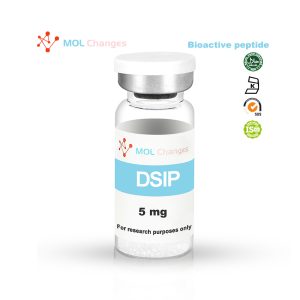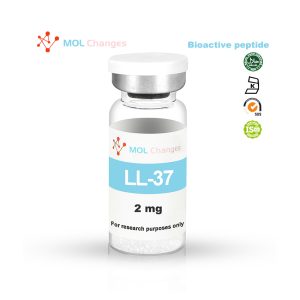Pinealon is a short peptide consisting of just three amino acids. It is one of a handful of synthetic peptides referred to as peptide bioregulators for their ability to interact directly with DNA to alter gene expression levels. Pinealon has been linked to behavior modification and is thought to help protect a number of cell types, including neurons, against the effects of hypoxia. By direct effect on the pineal gland, pinealon may reduce problems with drug metabolism, circadian rhythm disorders, memory, learning, and more.
Sequence
Glu-Asp-Arg
PubChem CID
18220191
Molecular Formula
C15H26N6O8
Molecular Weight
418.407
Pinealon Related research
Pinealon may have anti-aging effects in the central nervous system. Research from Russia indicates that pinealon and a similar peptide, vesugen, are anabolic in the brain and can actually slow the rate of aging when calculated using biological age indicators[2].
Pinealon is active in cells outside of the central nervous system as well. Research shows that the peptide also has effects on muscle cells where it alters the expression of irisin[3]. Irisin is important to protecting muscle cells during exercise, promotes fat burning, and is thought to induce telomere elongation as well. By increasing the lifespan of irisin, pinealon boosts telomere protection and helps to fight off the effects of aging and oxidative stress. In fact, plasma irisin levels are directly linked to telomere length in healthy adults and levels of the enzyme have been directly linked to calorie restriction, one of the few activities known beyond doubt to prolong life and improve overall fitness[4]. Interestingly, there is evidence that irisin is active outside of muscle cells and that pinealon may therefore have anti-aging effects that are broadly distributed throughout the body, including the brain.
Pinealon Research and Neuron Protection
Research in prenatal rats indicates that pinealon protects neurons against oxidative stress and thus protects cognitive function and motor coordination[5]. The study showed marked decreases in both reactive oxygen species accumulation as well as number of necrotic cells in the brain in these rats. In other words, pinealon protects neurons from dying.
The findings of the prental rat study discussed above have been confirmed in separate studies and extended in others. Confirmation that pinealon protects against reactive oxygen species and reduces necrotic cell death also came with the understanding that the peptide modifies the cell cycle as part of its protection against cell death[6]. This was one of the first indications that pinealon was almost certainly interacting at the level of DNA. Interestingly, pinealon modulates the cell cycle by activating proliferation pathways. Under normal circumstances, this would lead to an increase in cell number, but under the setting of oxidative stress, this effect simply offsets some of the damaging effects of reactive oxygen species.
Research in adult rats deprived of oxygen has also shown that pinealon increases the resistance of neurons to hypoxic stress. It appears to do this by stimulating innate anti-oxidative enzyme systems and limiting the excitotoxic effects of N-methyl-D-aspartate[7]. N-methyl-D-aspartate (NMDA) is an amino acid derivative that can kill nerve cells by over-exciting them. NMDA has been shown to become overactive during withdrawal from alcohol and is at least partly responsible for the “shakes” or delirium tremors that affects chronic alcoholics during withdrawal. NMDA has been linked to nerve death in traumatic brain injury and ischemic stroke.
Irisin, which has been discussed in the context of muscle cell protection, has recently been found in the brain where it plays important roles in neural differentiation, proliferation, and energy expenditure. Irisin levels in the central nervous system has been found to stimulate genes in the hippocampus that are important to memory, learning, the overall neuron health[8]. Research in rats suggests that exercise directly boosts levels of irisin in the brain, which may finally provide the link between physical activity and cognition. Scientists have speculated that irisin is the messenger that mediates crosstalk between skeletal muscle and the central nervous system during exercise. Pinealon boosts levels of irisin by altering expression of the gene that codes for the enzyme. This leads to increased levels of irisin through prolonged lifespan of the enzyme.
Pinealon research and Depression
Research in cultures of brain cortex cells indicate that pinealon can boost expression of 5-tryptophan hydroxylase via epigenetic changes. 5-tryptophan hydroxylase is critical to the production and secretion of serotonin, a peptide known to have neuroprotective and geroprotective features[9]. It is also the signaling molecule most often targeted by anti-depressive drugs called selective-serotonin reuptake inhibitors (SSRIs). SSRIs have a number of side effects, however, and the ability to boost serotonin production organically could offer a means of fighting depression that is more physiologic and thus reduce side effects.
Pinealon Protects Cells from Caspase-3 and Cell Death
The initial understanding that pinealon could affect the cell cycle came from research into the effects of the peptide in rat models of ischemic stroke. These studies revealed that pinealon affects cytokine signaling that normally leads to an increase in levels of the caspase-3 enzyme[10]. Caspase-3 is directly responsible for initiating apoptosis, or the controlled death of a cell via genetic instruction. By modulating caspase-3, pinealon shuts down at least one pathway to cell death and thus reduces the effects of oxygen deprivation during stroke.
Caspase-3 is not only active in neurologic tissue though, it is almost universal. Research using models of heart attack indicates that pinealon may reduce caspase-3 levels following myocardial infarction[11]. The short peptide may have application both in treating heart attack and in preventing the long-term remodeling that causes so much dysfunction following a myocardial infarction.
The benefit of pinealon in suppressing caspase-3 expression has been demonstrated in skin cells. By reducing apoptosis in the skin, pinealon promotes cell proliferation in both young and old animals alike. This leads to an increase in the regenerative process and has been shown to offset age-related pathology in the skin[12]. Pinealon may eventually form part of a multi-faceted approach to wound healing and could have application in everything from sun protection to serious burn treatment.
Pinealon Research and Sleep Regulation
It should come as no surprise, given its names, that pinealon affects that sleep-wake cycle as well as sleep behavior. Research indicates, that pinealon may help to regulate the dysfunction caused by shift-work and other activities (e.g. long-distance travel) that interfere with normal sleep patterns. The peptide actually appears to reset the pineal gland to baseline in the setting of circadian rhythm disruption, improving sleep, depression, mood, blood pressure, and more as a result[13].
The ability to regulate sleep actually corresponds strongly with rates of aging. Disturbed sleep is a recipe for disaster in the body and affects cognition, cardiac health, wound healing, mood, and more. Pinealon may therefore help to reduce the impact of sleep disturbance and thus offset the effects that it has on aging. This could be beneficial not only to those forced into disorder sleep due to their jobs, but to individuals suffering from organic disease that impacts sleep-wake cycles.
COA
HPLC
MS
- L. I. Fedoreyeva, I. I. Kireev, V. K. Khavinson, and B. F. Vanyushin, “Penetration of short fluorescence-labeled peptides into the nucleus in HeLa cells and in vitro specific interaction of the peptides with deoxyribooligonucleotides and DNA,” Biochem. Biokhimiia, vol. 76, no. 11, pp. 1210–1219, Nov. 2011.
- V. N. Meshchaninov, E. L. Tkachenko, S. V. Zharkov, I. V. Gavrilov, and I. E. Katyreva, “[EFFECT OF SYNTHETIC PEPTIDES ON AGING OF PATIENTS WITH CHRONIC POLYMORBIDITY AND ORGANIC BRAIN SYNDROME OF THE CENTRAL NERVOUS SYSTEM IN REMISSION],” Adv. Gerontol. Uspekhi Gerontol., vol. 28, no. 1, pp. 62–67, 2015.
- V. K. Khavinson, B. I. Kuznik, S. I. Tarnovskaya, and N. S. Lin’kova, “Short Peptides and Telomere Length Regulator Hormone Irisin,” Bull. Exp. Biol. Med., vol. 160, no. 3, pp. 347–349, Jan. 2016.
- K. S. Rana et al., “Plasma irisin levels predict telomere length in healthy adults,” Age Dordr. Neth., vol. 36, no. 2, pp. 995–1001, Apr. 2014.
- A. Arutjunyan, L. Kozina, S. Stvolinskiy, Y. Bulygina, A. Mashkina, and V. Khavinson, “Pinealon protects the rat offspring from prenatal hyperhomocysteinemia,” Int. J. Clin. Exp. Med., vol. 5, no. 2, pp. 179–185, 2012.
- V. Khavinson et al., “Pinealon increases cell viability by suppression of free radical levels and activating proliferative processes,” Rejuvenation Res., vol. 14, no. 5, pp. 535–541, Oct. 2011.
- L. S. Kozina, “[Investigation of antihypoxic properties of short peptides],” Adv. Gerontol. Uspekhi Gerontol., vol. 21, no. 1, pp. 61–67, 2008.
- J. Zhang and W. Zhang, “Can irisin be a linker between physical activity and brain function?,” Biomol. Concepts, vol. 7, no. 4, pp. 253–258, Aug. 2016.
- V. K. Khavinson, N. S. Lin’kova, S. I. Tarnovskaya, R. S. Umnov, E. V. Elashkina, and A. O. Durnova, “Short peptides stimulate serotonin expression in cells of brain cortex,” Bull. Exp. Biol. Med., vol. 157, no. 1, pp. 77–80, May 2014.
- A. M. Mendzheritskiĭ, G. V. Karantysh, G. A. Ryzhak, and S. V. Dem’ianenko, “[Regulation of content of cytokines in blood serum and of caspase-3 activity in brains of old rats in model of sharp hypoxic hypoxia with Cortexin and Pinealon],” Adv. Gerontol. Uspekhi Gerontol., vol. 27, no. 1, pp. 94–97, 2014.
- “Serum Caspase-3 p17 Fragment Is Elevated in Patients With ST-Segment Elevation Myocardial Infarction | JACC: Journal of the American College of Cardiology.” [Online]. Available: http://www.onlinejacc.org/content/57/2/220. [Accessed: 11-Jun-2019].
- M. A. Voicekhovskaya, N. I. Chalisova, E. A. Kontsevaya, and G. A. Ryzhak, “Effect of bioregulatory tripeptides on the culture of skin cells from young and old rats,” Bull. Exp. Biol. Med., vol. 152, no. 3, pp. 357–359, Jan. 2012.
- A. S. Bashkireva and V. G. Artamonova, “[The peptide correction of neurotic disorders among professional truck-drivers],” Adv. Gerontol. Uspekhi Gerontol., vol. 25, no. 4, pp. 718–728, 2012.
Article/Literature Citation Notes
The purpose of quoting the scientist and professor's article is to acknowledge, recognise and applaud the exhaustive development work that has been done to undertake this peptide research. The scientist does not in any way support or advocate the purchase, sale or use of this product for any reason, and MOL Changes has no affiliation or relationship, implied or otherwise, with the scientist.
warning
These products are intended for scientific purposes only for in vitro research and are not to be used for human, animal or unethical experiments, in vitro research (Latin: in glass) is conducted in vitro. These products are not drugs and are not approved by the Food and Drug Administration in any country for the prevention, treatment or cure of any medical condition, disease or illness. The introduction of this product into humans or animals in any form is strictly prohibited by law.






